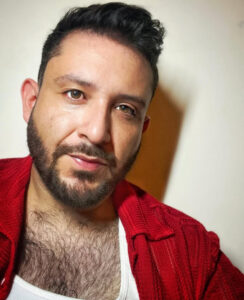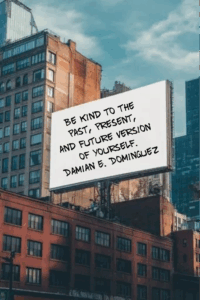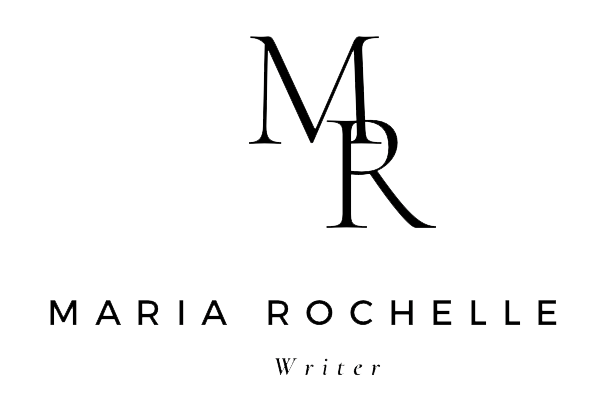
Damian is a native Daltonian and is living his dream as a costume designer out of Pittsburg, PA. He shares me 3 fun facts, his favorite costume design of all time, and advice to those who want to be a designer as well.
Introducting Damian…
What do you love about your life right now?
I’m feeling great about where my life is right now. I’m so grateful for my job, my friends, my family, and my home. There’s so much to love!
First off, I looked at your resume and your costume design on your site, and they were very impressive. Fantastic work by you! You have designed a lot for theatre and opera houses, too.
One reason I enjoy theatre and film so much is because of the costumes, especially period pieces.
Was there a particular play or show that inspired you to become a costume designer?
There are so so so many films and theatre productions that have driven me to the point where I am today, but I have a very vivid memory of the first time I recognized the power of costumes. Too many, this moment probably wasn’t as impactful as it was for me, and to this day, I honestly couldn’t tell you why it is burned into my memory. But back in 2007, my friends and I went to the movies to see Atonement, a period film with James McAvoy, Keira Knightley, and Saoirse Ronan, and there’s this moment in the movie where Keira Knightley’s character walks down a hallway in this incredible green dress. At the time, I couldn’t tell you what I was looking at, but I remember being in pure awe as I watched her glide across the screen and thinking “Holy. Shit. That (the dress) is incredible.” Now, I can tell you all about the 1930s inspired bias-cut silk satin gown designed by costume designer Jacqueline Durran, but even at those early stages, I knew it was something powerful.
I know very little about costume design. I admire individuals like yourself who have the talent and gift to be one. How does designing a costume work? For example, for The Winter’s Tale that you were the costume designer for, what’s the first step?
Research, research, research. Every project, regardless of the period, the size,the budget, etc., it always starts with research, sometimes even before you read the script. I enjoy learning about the playwright before I even jump into the script so I can have a better understanding of where and why the story was written. After reading, the research continues. You start homing in on the period of the show, or the events taking place, the location, all the elements that make the story what it is. All of it ultimately dictates what the clothing is going to support.There are usually so many questions that need answered before you can even jump into designing the specific garments, so research is key.
How do you envision the beginning to the end of all the costumes you design? I imagine obviously you have a plan, then steps to accomplish all of your designs.
Every process is unique, but they all follow a similar structure. Like most jobs in the entertainment industry, costume design is part of a major collaborative process. In theater, I’m working with the director, scenic, lighting,and sound designers. Depending on the production, sometimes wig, hair, and make-up designers. And typically, after we’ve all done our own research, we come together and discuss the project, and this is where my process begins. We start building the world we’re going to live in, and we all bring our own skills to the table. The collaborative process is my favorite part of this job. I’ve been lucky enough to have worked with some incredibly talented directors and designers, and there is something so special about working with a team that “speaks the same language.” It’s truly magical. After we establish our world, we split up and really start fleshing out our elements. It’s at this point that I dive further into the clothing and the characters and really start designing. Along the way, I’m constantly communicating with the rest of the team because what they’re doing directly affects what I’m doing and vice versa. What color is the set? Will the actors be wearing mics? What colors will lighting be using in this scene? This is when the actual design work is happening. Where the planning starts. Once the team has the show designed, we begin the more technical and logistical part of our individual areas. Which costumes are we making? What are we renting? What are we buying? You’ll eventually reach a point where you work on productions where everything is made, but I’m not there yet. Yet. And before you know it, you’re in fittings and then suddenly first dress rehearsal!
Did you design all the costumes for The Winter’s Tale which was at the Pittsburgh Playhouse last year?
Winter’s, yes, and no. When you work on productions with incomplete builds, resourcefulness and creativity are essential. Across the country, theatres rent/borrow costumes from each other and from established rental companies. Most theaters usually have a stock of costumes that you can use as well. With projects like this, the focus becomes on pulling together costumes from different sources to create a cohesive stage picture in the world you’ve created with your collaborators. And that’s what I had to do with The Winter’s Tale. Pittsburgh Playhouse has a great costume shop, but with a show of that size, there was no way the shop could handle building the entire show. That’s where my job comes in. I choose what pieces I want built, based on the needs of the show and based on what I know I will have trouble finding. From there, I start putting together looks for all the characters, keeping the overall vision in mind as I go into every fitting.
What have been some joys and challenges as a costume designer?
As with any type of freelance work, the biggest challenge is never really knowing what’s next. Some years, the work keeps coming and coming, and other years, you’re hoping something comes up. Sometimes it does and sometimes it doesn’t.
Although the start was incredibly difficult, I’m lucky to be at a career point with consistent work and many enjoyable aspects. I love the collaborative process with designers, makers, directors, actors. I’ve worked with some incredibly brilliant people that make this job worth waking up for every single day. Additionally, there is no other feeling like the one you feel when you see it all come together for the first time. It’s magical.
Is there a particular costume that has been your all-time favorite to design?
Using: A team of crew members spent hours cutting up CDs, which we then assembled onto the individual spokes of the wings.There have been so many! The one that comes to mind is the costume for the Angel of War in Marisol by Jose Rivera during my second year of grad school. Because of someone issues securing rights for another play and the budgeting for the season, I only had a $500 budget for the entire show. Aside from a few purchased and pulled items, my assistant,Oona Atesan,(@oonanatesan) and I crafted so many pieces out of recycled items. At one point, I was pulling an umbrella out of a trashcan that ultimately made it into the show! The Angel of War was no exception. We built the wings out of corrugated plastic and cut up CDs. A team of crew members spent hours cutting up CDs before assembling them onto each spoke of the wings. A team of volunteer engineers also provided the equipment and expertise, allowing us to install a motor for button-activated wing deployment. We made her gauntlets out of flattened bottle caps, and her armor was made of wire and colored zip ties. Seeing the costumes, onstage for the first time, the CDs reflecting under the lights, the mechanical opening of the wings, and the presence of the actress wearing it. It was incredible and so rewarding!
Do you have one that was the most difficult to design, and if so, why?
The Angel of War was a difficult one, but another one that was challenging, but equally as rewarding, was the transformation dress in Cinderella. Many productions have created this dress, but it still takes a lot of work to figure out how to make it happen. I worked with the draper Patrick Geraci (@patrickgeraciart) and shop manager on the mechanics of how the dress would work, and I provided renderings for what my vision was for the dress post transformation. The challenge was making the dress “fit” into the pre-transformation look without it looking awkward and bulky. I had this vision of it looking like flower petals blooming, taking inspiration from Dior’s “Junon” dress, and we ultimately succeeded. It was a beautiful moment.
Who do you look up to in the industry?
Paul Tazewell, the designer of Hamilton and the film adaptations of Wicked and West Side Story. During the pandemic, I was fortunate enough to meet Paul virtually; he was such a kind, humble, generous, and inspiring person. His work speaks for itself. It’s incredible! I aspire to be a designer who works in both theatre and film/TV, and to see someone like Paul make it happen so successfully is exciting and inspiring. His work is truly art, and I admire his eagerness to credit the entire team that makes his designs come to life. From craftsmen to crewmembers, there is not one person I haven’t seen him publicly thank, and that is such an admirable quality in any designer.
Besides being a costume designer, you’re also a stylist. What does that entail?
There’s obvious overlap in how I approach both, but when it comes to costume design, I’m creating looks for a character within a specific narrative. Styling is more focused on emphasizing a person’s aesthetic. Both require having a knowledge of silhouette, fit, appearance, but they have different ultimate goals.
Is there any advice you would give to someone who is wants to pursue a career as a costume designer and stylist?
Start and keep going. It’s the hardest part. The industry is incredibly challenging and sometimes it feels like giving up is the only option. I have definitely been there. But if you keep going and push through the challenges, you’ll realize you’re in a field that’s so fulfilling and rewarding.
In order for us to have success, there’s failure that we have had to deal with. If possible, do you have a favorite failure?
I can’t say I have a “favorite” failure, but like so many of my colleagues, 2024 was a rough year. I work in both theatre and film/TV, and I rely on both to make a living. However, when the SAG and Writer’s Guild strikes happened, it really affected my income in a way I hadn’t experienced before, and it opened my eyes to the feast and famine nature of this line of work. I had several friends and colleagues abandon the industry altogether because the situation was so rough. I learned a valuable lesson about how to plan for this type of unprecedented situation, and I feel ready for the next time something like this happens.
Who are your biggest supporters in your career?
My family, friends, and mentors have been instrumental. I have toughed through some really hard spots, and I honestly couldn’t have done it without them. To any of you reading this, I can never say thank you enough for pushing me to keep going! I wouldn’t be where I am without every bit of support you’ve given me.
If you could have a gigantic billboard anywhere with anything on it, what message would you want to convey to millions? What would it say and why?
Be kind to the past, present, and future version of yourself. We can learn from our past mistakes. Regret is never fun, but you can’t dwell on it forever. Be mindful of the choices you make today so your future self can thank you.

Describe yourself in one word.
Ambitious. I always dream big. I have to keep myself in check sometimes. However, I really want to look back on my career and be proud of the work I have done and the work it took to get there.
What are you currently working on?
I’m currently working as a full-time shopper on Mayor of Kingstown, and I’m also designing Birthday Candles (City Theatre), Anna Bolena (Resonance Work), and The Seagull (Quantum Theatre).
This part of the interview is one of my favorite sections and last question. Tell me three fun facts about you.
I was almost in the cast of the second season of Top Chef: Amateurs. I love to cook, and during the pandemic, I auditioned and made it very far. They invited me to participate in the pitch package for the second season, but sadly, the show was canceled.
I survived a scorpion sting. When I was 18, my uncle rushed me to a hospital, and I spent eight hours hooked up to an IV and received three doses of antivenom. I obviously survived, but it was a scary moment.
When I was in fourth grade, I joined a poultry judging team through 4-H. Why? I have no clue. Intrigue? Couldn’t tell you. I never actually competed because I was out of town for the competition, but it’s something I did that still has me questioning a lot of things.
Thank you for reading my interview with Damian. Follow him on Instagram and check out his website and his designs on it.
